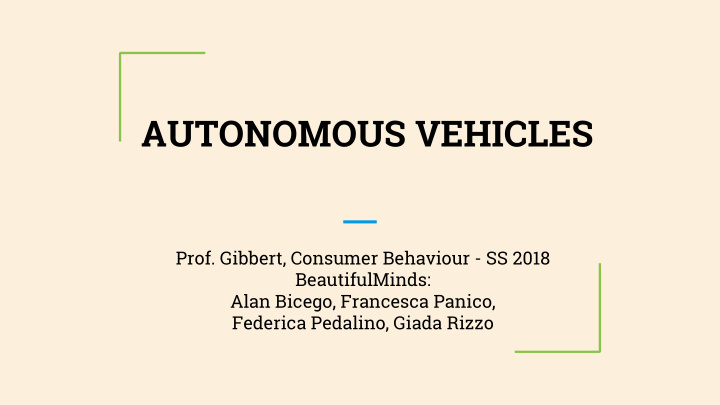



AUTONOMOUS VEHICLES Prof. Gibbert, Consumer Behaviour - SS 2018 BeautifulMinds: Alan Bicego, Francesca Panico, Federica Pedalino, Giada Rizzo
Characters description ALEXA JOHN 30 years old 56 years old ● ● American American ● ● Echo-boomer (Millennial) Baby-boomer ● ● Junior Human Resources Recruiter Banker - private consultant ● ● Single Married - 25 years of marriage ● ● Ambitious and career-driven No children ● ● Heavy user of new technologies Settled, but loves to try new ● ● User of public transport - drives a car technologies (innovator/first user) ● only during the weekend ● Drives a car every day - work use as well
What motivates you to buy an autonomous vehicle? Hedonic need the idea of using an Utilitarian need → work reason: even if I ● → ● autonomous vehicle changes an usual action usually drive during rush hour, with like driving in something futuristic. Moreover, autonomous vehicles, I could read the I perceive this car as a luxury product and documents of the client while reaching them. since I am a woman in career, this car is Partially hedonic → I love the futuristic ○ appealing to me. These technological and idea that the autonomous vehicle gives luxurious fantasies make me want to have me, since I love technology and it this kind of car. makes me live my kid fantasies. ○ Partially utilitarian → this car is useful ● No real need but I definitely want it ! in driving me home after a night out or to go to work when I don’t want to use public transportation. ● I don't really need it but I would like to have it!
Do you have conflicting motives about this car? Approach-avoidance → on one hand, I would Approach-approach → I love driving, thus I ● ● like to drive this kind of car, but on the other would appreciate also a not fully autonomous hand, I also consider the potential negative vehicle (brakes, speed, parking assistance), consequences of it: but the idea of a completely autonomous car I fear the fact that I don’t have much is really appealing too for the positive ○ control on it consequences : A widespread adoption of autonomous Less stress ○ ○ vehicles can lead to the loss of driving- ○ Use time more efficiently related jobs ○ Even if I’m tired or sick I don’t have to ○ Too much technology might create worry about driving some problems ○ I don’t have to pay anymore for the damage of my wife when she parks!
Maslow hierarchy of needs
What are the characters’ attitudes toward this object? Experiential hierarchy ● Standard learning hierarchy ● Feel → Do → Think ○ Think → Feel → Do ○ Affective ○ Cognitive ○ ○ Alexa has created a lot of emotional John would seek a lot of information ○ values and responses toward this about the new autonomous vehicle objective. These fantasies drive her technology. Next, he recognizes the motivation and determine her attitude characteristics and functions, ● Cognitive dissonance theory → She has understands the benefits and forms conflicting motives toward the object feelings. Finally, he would purchase the ○ Could the actual use of the product car or recommend it to others change the emotional impact that ● Self-perception theory → lot of technology drives the attitude? Cognitive → use and driving leads to a perceived positive dissonance after purchase attitude towards autonomous vehicles
What are the characters’ decision-making processes? Affective bucket Cognitive bucket Alexa is fascinated by the idea of having an John realizes that a new technology for cars ● ● autonomous car because it is technological is on the market and that could improve his and futuristic everyday driving experience, so he wants to She starts to search for information related change his old car ● to this product: she googles it and discusses He goes to a car dealer to ask for information ● about it with co-workers/friends/family related to this product members to get different points of He carefully analyses the wanted ● view/opinions characteristics and proceeds to compare ● She might also consider not completely different models autonomous cars ● John decides to purchase a specific model of ● She repeats the steps 2 and 3 several times autonomous vehicle because it better fits his according to the dissonance she experiences needs and desires (approach-avoidance conflict) ● John happily doesn’t drive his car :) ● At the end, she will not buy the car
How to change Alexa’s behaviour? Reduce the dissonance magnitude : ● Autonomous vehicle manufacturers → provide more information to lower the fears of Alexa → more ○ advertisement on the media and social networks Driving organizations → keep the job ○ Useful to limit the conflict to an approach-approach kind → Alexa should only question about ○ driving a completely autonomous car or a partial one → regular cars not an option ● Emphasize more the utilitarian functions → show how this new technology can improve your everyday life → less stress when driving, more time to do your work on the go ● Use the foot-in-the-door technique → introduce this technology into other sides of life (public transportation), and include it slowly into regular vehicles (speed control, etc .)
THANK YOU FOR YOUR ATTENTION!
Recommend
More recommend